Introduction
The presentation focuses on patches and their role in the counterculture fashion. Over the century, the significance and meaning of patches in fashion have evolved. From a practical and highly utilitarian thing, they turned into a mean for garment ornamentation, development of personal or brand identity, and even making public statements. Although the application of patches in the mainstream fashion movement is rather a recent innovation, they were an intrinsic part of counterculture for a significant time. Moreover, their use was largely influenced by various social-cultural changes.
Considering this, the major purpose of this exhibit is the demonstration of how the social events impacted individuals’ choices in fashion throughout the history. Focusing on patched denim, we will review the links between social factors and fashion.
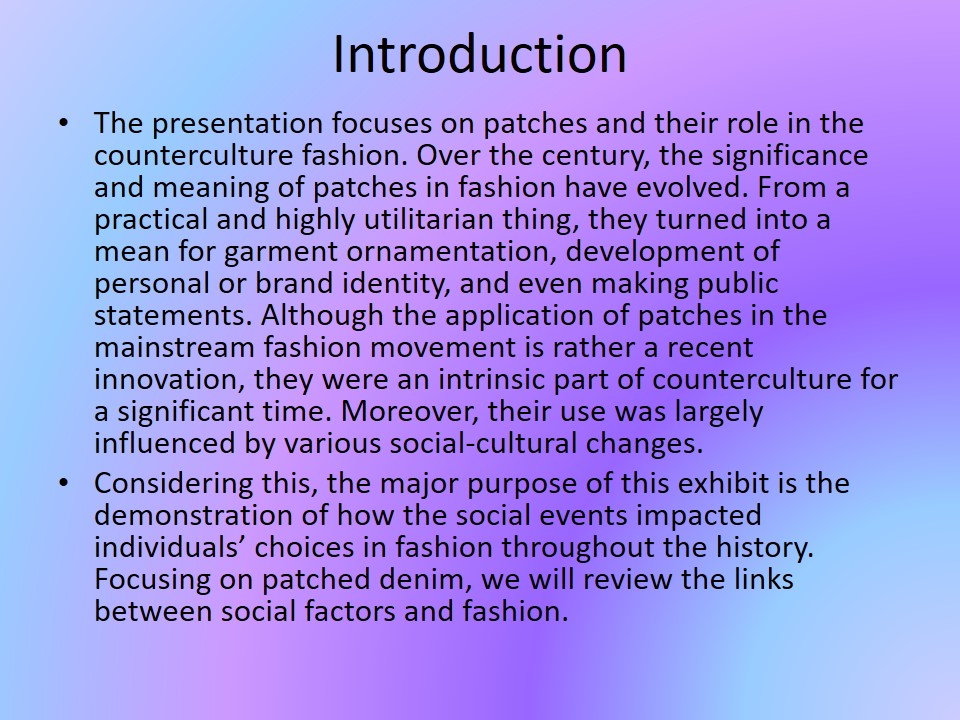
Historical Overview
The history of patches in fashion started in 1960’s when young people protesting the war in Vietnam were flooding the streets. They wore patches with peace emblematic and make-love-not-war statements. Along with the political revolt, those individuals were engaged in many cultural activities: music, literature, art. Thus, later the anti-war movement turned into a larger culture and people involved in it became known as the “children of flowers” or hippies.
The hippie culture thrived throughout 1970’s-1980’s, and, during this time, the use of colorful and bright patches became widespread as hippies used to move against the current and buy second-hand clothes which they then repaired themselves. Hippie patches showed off the iconic images of the movement and contrasted their looks to the preppy and well-tailored garments of the mainstream culture.
In the late 70’s, the punk movement arose and started to gain momentum. Like hippies, punks used patches to express their identity. Along with pins, spikes, distressed denim, and brightly colored hair styles, patches contributed to the rebellious and marginal punk look which remains iconic today and continue to inspire youth and people in fashion.
Nowadays, hipsters constitute the major subculture. According to McKenzie, they use various fashion means to express their rebellious identity and mindset just like their predecessors. By integrating patches in their looks, hipsters may proclaim their otherness and unwillingness to comply with the rules and social norms. In this way, it is possible to say that the patch was and remains the symbol of freedom of choice and the counterculture as such.

The Objects
Exhibit 1: The embroidered and patched denim shirt and jeans. It is a well-preserved exhibit from late 60’s-70’s. Although the garment seems to be without any sign of distress and the patches are put on the “imaginary’ holes and, first of all, are used as decoration, it shows the current fashion trends and how they were inspired by the counterculture. The costume integrates the patches and embroideries depicting symbols and images associated with the hippie movement: rainbow, flowers, and phrases such as “Love is a 4 letter word.”
Exhibit 2: Levi Strauss & Co, Hand-embroidered and patched jeans, circa 1969. Although the jeans are heavily patched, their style is less screaming and bright. Still, the garment makes a statement against the growing materialism in the US society of that time. According to the Museum at Fit, hippies valued denim for its “working class connotations,” and by modifying it with patches and hand-made ornaments, they reversed this symbol of the American working class into a method of protest.
Exhibit 3: Jeans manufactured by Lee Jeans in 1971 and then patched by their owner during the following five years of wearing. The given garment is an example of the protest against the mainstream culture (and fashion, in particular). The owner of the jeans patched them as the denim ripped and became distressed more. This piece does not have bright colors and rainbow symbolic, yet it represents what the hippie movement was all about and perfectly captures the spirit of the movement.
Exhibit 4: Customized denim jeans with cotton patches, ribbons, and applications; circa 1970. Embroideries and patching in excess numbers were not just the means of decoration. According to Burke, the “ferocious demonstration of color, design and craft was a major participant in the political narrative.”
The period from 1970’s till 1980’s is characterized by an individualized approach to fashion among the members of the counterculture. The emphasis is made on optimism and freedom of expression (Kass).
Exhibit 5: The jacket heavily strewn with spikes and patches. Similar denim and leather items were important parts of the wardrobe of every punk in the 1980’s. Frequent images on the patches were skulls, skeletons, crosses, and so on. Some patches could include such phrases as “Punks Note Dead.” This type of styling communicates with the public and may even instill the sense of danger or threat. However, the major purpose of punk style was the development of self-identity. By wearing such garments and patches, punks identified themselves as opposite to mainstream values and norms, and, at the same time, criticized them
Exhibit 6: The modern example of a denim vest covered with large patches. The given piece is typical for the hipster subculture. The patches communicate the messages with the social implications. Such phrases and words as “Problem,” “Someone’s Alone” may be symbols of arrogance and unwillingness to be in the company of other people. As stated by Haight, the fashion elements inspired by previous epochs (patched jeans and denim garments, in particular) represent freedom and “an enticing mix of rebellion against sexual norms, military power,” and fashion and tailoring itself. These features are intrinsic with the present-day counterculture.

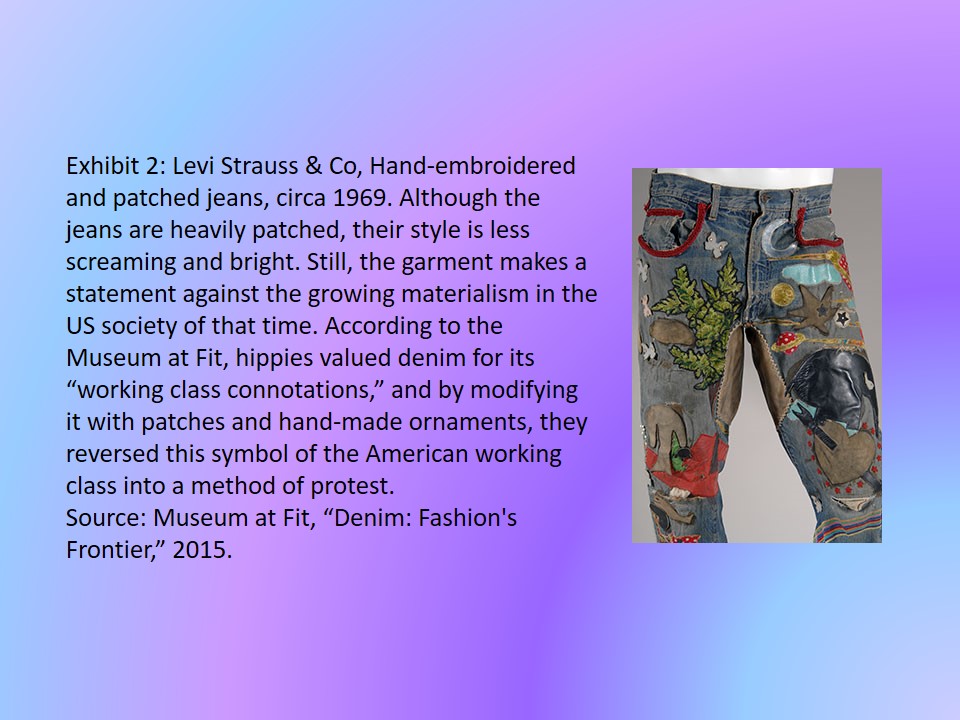
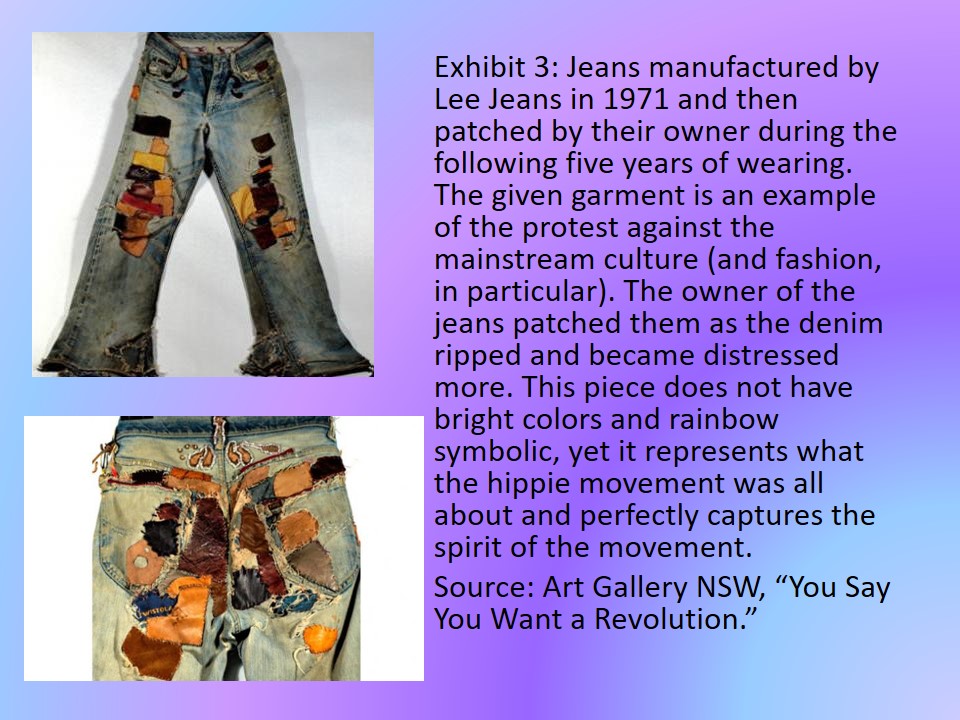
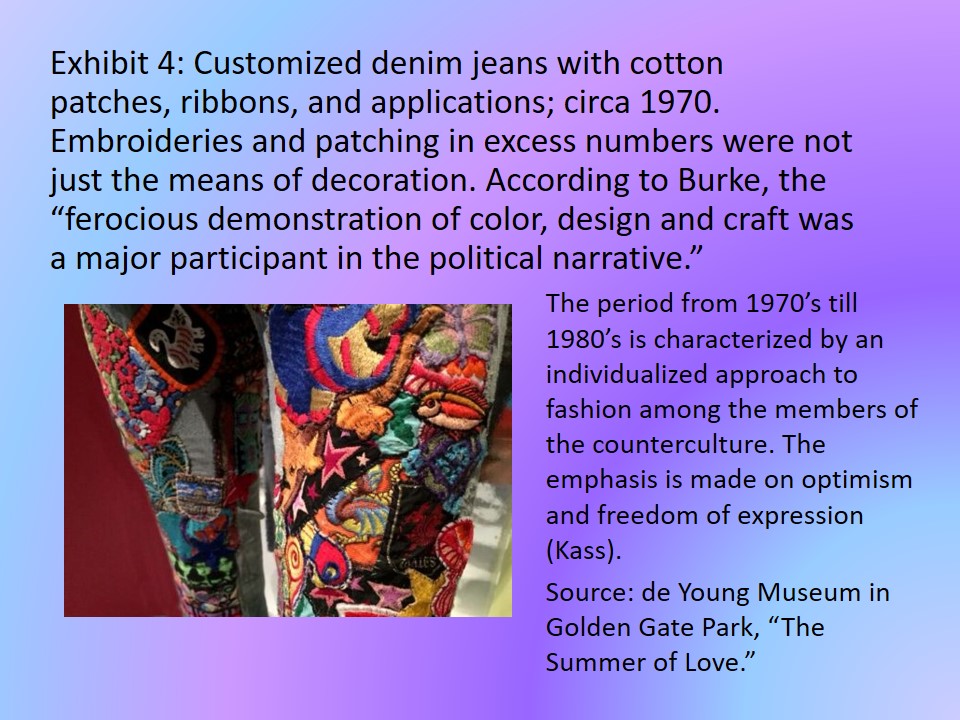
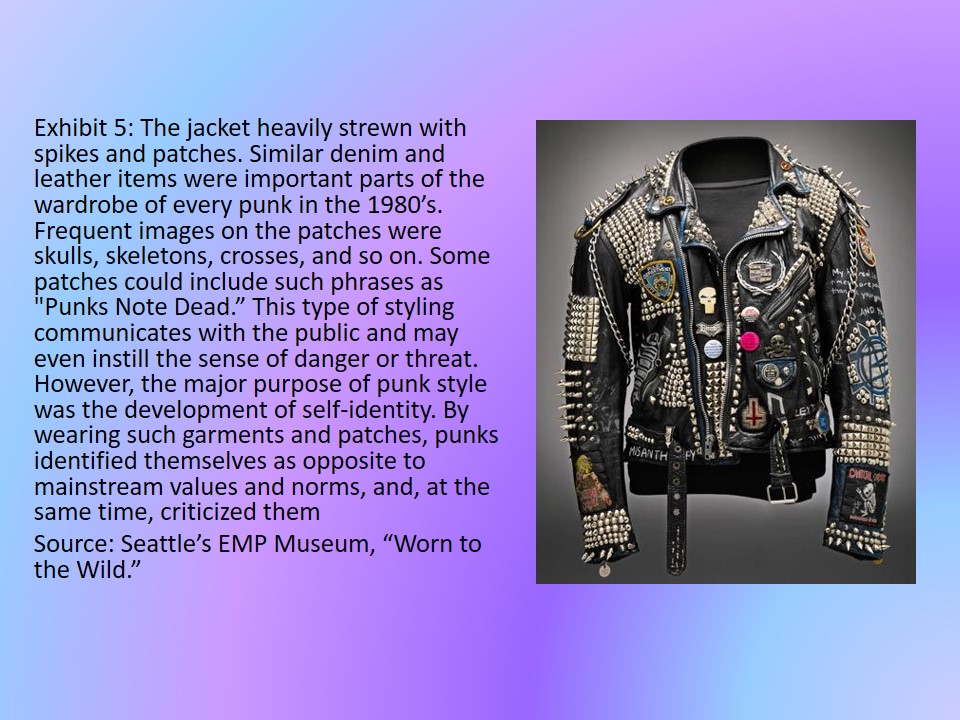
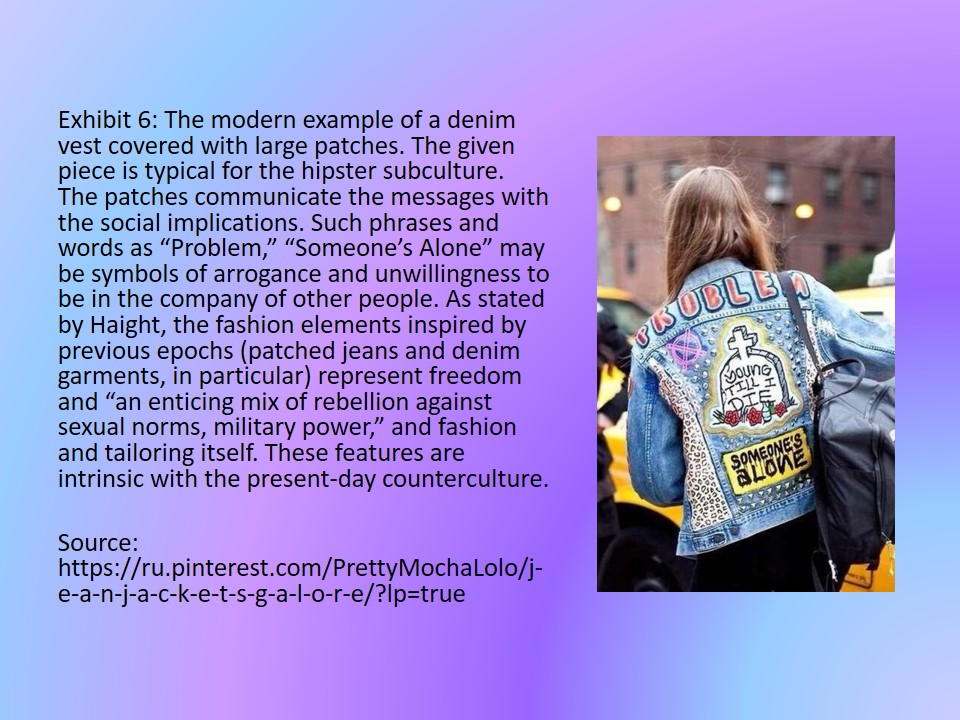
Conclusion
In every epoch, fashion reflects common attitudes of people, their values, and aspirations. When speaking of patches, they have become an important attribute of the apparel design and their current functions go beyond the initial one (i.e., repairing of old and distressed clothes) − they now allow individuals to communicate with others and show personal identity to them.
During the period of hippie culture, heavy use of colorful patches and embroidery was a way of political revolt. Patches often included pacifist statements and optimistic symbols. With the onset of punk movement, patches became more aggressive and dark yet, at the same time, they were used to express the rebellious nature of the subculture − the opposition to materialism and social conventions.
Nowadays, inspired by the fashion legacy of punks and hippies, representatives of counterculture, hipsters, use patches to demonstrate their own stance, i.e., deviation from social norms, individualism, and so on.
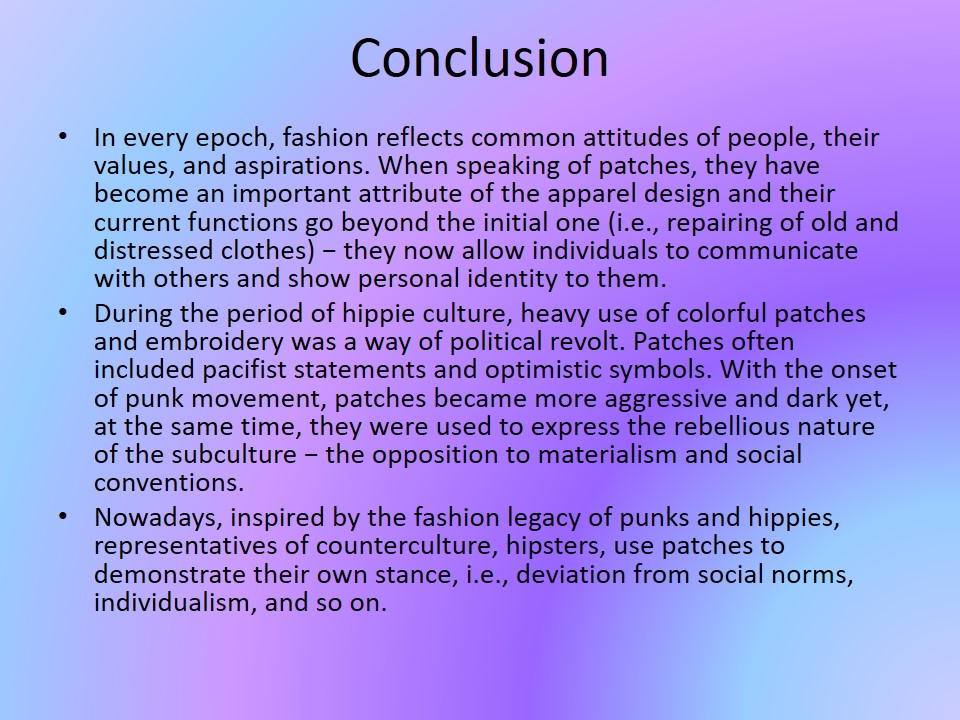
Works Cited
Burke, Pamela. “Design: Summer of Love – The de Young’s Exhibit of Unity, Activism and Change.” The Women’s Eye, 2017. Web.
Haight, Sarah. “Fields of Fashion.” WWD, vol. 198, no. 29, 2009, pp. 6, ABI/INFORM Trade & Industry. Web.
Kass, Alison. The 20th Century of American Fashion: 1900 – 2000. Thesis, WSCU, 2011.
McKenzie. “Hipsters – A Sub and Counter Culture.” Popular Culture. 2011. Web.
The Museum at Fit. “Denim: Fashion’s Frontier.” Fashion Institute of Technology. Web.